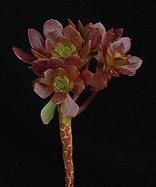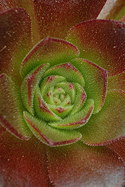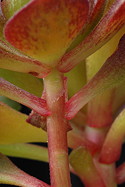The late Jack Catlin is known for his popular dark-leaved Aeonium hybrids derived from the Dutch selection, A. arboreum ‘Zwartkop’. In most of these, the arborescent tendency of A. arboreum is apparent in the hybrids, which become leggy as the plants mature and have rosettes only at the tips of bare stems. For mass bedding in the landscape, this necessitates beheading and replanting every few years if a low block of unusual dark foliage is desired. Jack commented that he really was hoping for smaller, clumping plants. Unfortunately, he never got around to developing this line further with some of the species that might yield a more compact habit. Picking up where Jack left off, John Trager crossed A. ‘Jack Catlin’ (ISI 2009-10) with A. sedifolium, the most diminutive member of the genus with 2.5 cm rosettes of plump leaves atop densely-branched, cushion-forming plants. The parentage of A. ‘Bing Thing’ then is (A. tabuliforme × A. arboreum ‘Zwartkop’) × A. sedifolium. The result is a plant with 6 cm rosettes on branching stems to 20 cm or so tall. The leaves have a slightly glutinous (sticky) quality as in A. sedifolium. Though not nearly as dark as A. ‘Zwartkop’, the leaves do have a dark reddish cast, especially during summer, and some of the reddish markings of A. sedifolium appear as a speckled pattern, especially on the undersides of the leaves. This speckling resembles that of the fruit of the commercial cherry variety ‘Rainier’. Not being able to remember that name at first, the more common cherry variety, the ‘Bing’, came to mind. Even though that variety is a solid deep burgundy color, the name ‘Bing Thing’ stuck. Rooted cuts of HBG 108053, $10.

Published in the Cactus and Succulent Journal, Vol. 84 (2), March - April, 2012


